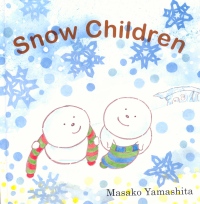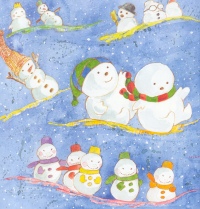| ________________
CM . . . . Volume XIX Number 3 . . . . September 21, 2012
excerpt:
Masako Yamashita's picture book, Snow Children, delves into the important yet complex issue of global warming. Written in the third person, the story unfolds with the two principal characters, Yuna and Yuta, attending an ice festival. Both take note of the warmer temperatures, but from different perspectives. Yuna enjoys the warm weather while Yuta is clearly concerned and suggests the two attend an international meeting about the changing climate. On the way to the ice hotel where the gathering is to take place, the two encounter several animal families who are struggling in their habitats, but once the pair reach their destination, it becomes evident there is a difference of opinion amongst the snow people as to the gravity of the situation. Thankfully, the combination of beautiful snowflakes falling from the sky and the encouragement of Yuna and Yuta helps to convince the snow people they must work together to find a solution.
The illustrations in the story are simply wonderful, presenting a visual panorama of wonderfully blended colours that serve as the background for richly detailed and decorative drawings. Moreover, Yamashita has created an atmosphere where both the illustrations and text work together to bring meaning to the story. The font is simple and clear, set either on the bottom or side of a page so as not to interfere with the more elaborate illustrations. In many ways, the gathering of snow people to talk about global warming mirrors worldwide discussions that are often polarized. However, Snow Children sends the message that climate change should be recognized, understood, and overcome in harmony. While the book deals with a serious topic, the author seems to recognize the priorities of this age group as exemplified by the statement of the meeting speaker: "Welcome, snow people. We've got lots to think about! But first, let's eat!" Highly Recommended. Harriet Minuk is a librarian at Winnipeg Public Library in Winnipeg, MB.
To comment
on this title or this review, send mail to cm@umanitoba.ca.
Copyright © the Manitoba Library Association. Reproduction for personal
use is permitted only if this copyright notice is maintained. Any
other reproduction is prohibited without permission.
NEXT REVIEW |
TABLE OF CONTENTS FOR THIS ISSUE
- September 21, 2012.
AUTHORS |
TITLES |
MEDIA REVIEWS |
PROFILES |
BACK ISSUES |
SEARCH |
CMARCHIVE |
HOME |

 Yamashita successfully explores the consequences of global warming by presenting examples of animals that children can readily relate to. The reader sees a family of rabbits covered by an avalanche, polar bears trapped on ice floes, and caribous that can't find food in the snow. Prior to beginning the story, Yamashita offers context by listing the many effects of climate change, including an increase in rain and snow, violent storms, as well as more complex changes, such as melting glaciers and changes in animal environments. Similarly, at the end of the story, the author provides concrete examples of what children can do to help prevent global warming, things such as walking, biking, or taking the bus or subway to a destination instead of riding in a car. By itself, this information might be considered difficult for children in the intended age group to fully comprehend, yet, within the framework of the story, it could serve as an opportunity to inform, thereby opening up the possibility for questions and discussion.
Yamashita successfully explores the consequences of global warming by presenting examples of animals that children can readily relate to. The reader sees a family of rabbits covered by an avalanche, polar bears trapped on ice floes, and caribous that can't find food in the snow. Prior to beginning the story, Yamashita offers context by listing the many effects of climate change, including an increase in rain and snow, violent storms, as well as more complex changes, such as melting glaciers and changes in animal environments. Similarly, at the end of the story, the author provides concrete examples of what children can do to help prevent global warming, things such as walking, biking, or taking the bus or subway to a destination instead of riding in a car. By itself, this information might be considered difficult for children in the intended age group to fully comprehend, yet, within the framework of the story, it could serve as an opportunity to inform, thereby opening up the possibility for questions and discussion.